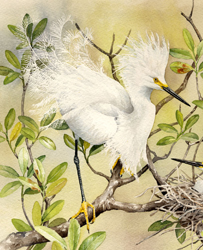Breeding Bird Atlases (BBA)
Find a Bird - BBA1
Breeding Bird Atlas 1 Species Accounts
Snowy Egret
Egretta thula
Egg Dates
second week of April to June 11
Number of Broods
one

During the early 1800s, Snowy Egrets nested as far north as New Jersey, but the population was nearly exterminated by the plume hunters of the millinery trade by the turn of the century. Once full protection was afforded, the species managed to recover and expand its breeding range. Snowy Egrets were rare vagrants in Massachusetts until about 1950, when they became regular visitors in small numbers, mostly in late summer and fall.
They were first recorded nesting in July 1955, at Quivett Neck, East Dennis. Since then, they have established about a dozen colonies along the coast, including colonies at Madaket Ditch and Polpis Harbor on Nantucket, several colonies on Chappaquiddick Island, and a colony at Menemsha Pond on Martha’s Vineyard. The largest colonies were at House Island, Manchester, with approximately 250 pairs until the colony’s collapse in the early 1980s, and at Clark’s Island in Plymouth Bay, which supported about 250 pairs from the early 1970s until its final abandonment in the 1980s.
Snowy Egrets begin to arrive in Massachusetts in early April and can be observed foraging in the marshes and ponds near their breeding colonies. Primarily diurnal feeders that frequent a wide variety of open aquatic habitats, they have the most diverse repertoire of foraging behaviors of any egret species thus far studied. Snowy Egrets feed by walking slowly, walking quickly, standing, foot stirring, and hovering, but they very often run actively in pursuit of prey.
They commonly forage in sizable flocks and may follow livestock or other bird species, using them to stir up prey. Snowys have a diverse diet, which consists primarily of small fish, shrimp, snails, aquatic insects, and small frogs.
Breeding activity in Massachusetts usually begins in April and peaks by mid-May. Snowy Egrets are colonial breeders, frequently nesting with other heron species. They are highly social, and a half-dozen or more nests may occupy the same tree. At Clark’s Island, they commonly have used Highbush Blueberry, Arrowwood, Red Cedar, and Black Cherry for nesting.
Snowy Egrets are territorial during the breeding season, defending their nest and its vicinity with a variety of aggressive displays, including a “forward display” (Palmer 1962) in which the bird fully erects all of its head, neck, and back plumes and typically emits harsh, low-pitched aah calls. In “snap display” (Palmer 1962), a bird extends its neck fully with head level and crest erect and makes snapping sounds with its bill. Fights are common early in the breeding season. Snowys have a variety of vocal displays, including an aarh advertising call and an arg-obble call. Males attempt to attract females with “stretch display” (Palmer 1962), bending the head over the back with bill pointed upward and pumping the head while uttering an a-wah-wah-wah call. In the aerial variant of this display, the bird flies around calling with all its plumes erect. The display of the spectacular aigrettes accompanies all of the courtship rituals, including the elaborate nest relief ceremony. The lores and feet of advertising males turn bright orange or cherry red.
The nest is a loosely woven platform of twigs and sticks less than 3 feet in diameter. Snowy Egrets will frequently refurbish old nests rather than construct new ones. The male gathers nest materials and delivers them to the female with a noisy greeting. The eggs are a light bluish green, commonly three to five in number. The incubation period is approximately three weeks long and is shared by both parents. Hatching is asynchronous, and the smallest chick often starves. Both parents feed the young, and the chicks emit an extremely harsh begging call or shriek. They are capable of climbing about the nest tree after two weeks and can fly after about a month. At the Clark’s Island heronry in 1975 and 1978, nesting success was good, with most pairs of Snowy Egrets rearing at least two young to 10 days of age, after which time they began to move about and were hard to find.
In late summer, Snowy Egrets and other heron species gather in sizable communal roosts to spend the night. The roosts may or may not be located at a breeding site and may be augmented by birds that have dispersed from farther south. Some individuals wander inland. Fall migration begins in September. Atlantic Coast birds winter from New Jersey south to northern South America.
Map Legend and Data Summary
Atlas 1 data collected from 1975-1979


Note: locally common at coastal island heronries; increasing
William E. Davis, Jr.



